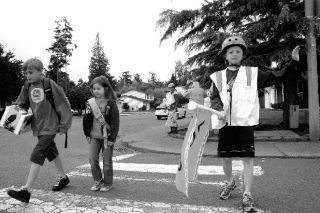State, city, school district team up
Grandpa might reminisce about walking to school on frostbitten feet clad only in Saran Wrap as he battled whiteouts and ice storms, daily occurrences in the “olden days,” that swept through the Pacific Northwest.
The younger generation, however, will decades from now weave tales of far more dangerous conditions. And they will speak without hyperbole.
Harrowing tales of near misses – or near hits – with SUVs as big as doublewides will hold the grandkids rapt. And the road rage … oh, the road rage.
The state, city and school district are teaming up to help kids negotiate these hurdles and make it safe for the youngsters to walk and bicycle to school. Education cannot exist without student attendance. And attendance is impossible without the child’s safe arrival.
A state Department of Transportation program is equipping school districts with the resources to establish safe routes to the educational facilities.
The Oak Harbor City Council agreed to contribute $30,000 to the Safe Routes to School Program. The contribution is contingent upon the school district being awarded the state grant.
The council voted to partner with the school district in submitting the application for the grant, worth between $400,000 and $500,000, depending on the scope of the district’s bike and pedestrian education program.
“This program is important because it makes it easier for kids to walk and bike to school,” said City Project Engineer Arnie Peterschmidt.
The federal, state and local effort to enable and encourage walkability and biking as viable transportation is broken up into three elements: education, engineering and enforcement.
The first component, which complements the Island County Health Department’s continuing efforts to promote walkability, is already underway in the district and will proceed regardless of grant funding. Joyce Swanson, Broad View Elementary principal, lauded the efforts of the Health Department’s Whitney Webber in supporting and promoting walkability programs.
“She has been instrumental in pulling the Oak Harbor School District, the Oak Harbor Police Department, and the city of Oak Harbor together in a partnership for a strong Safe Routes To School grant application,” Swanson said.
A “walking school bus,” supervised by volunteers who walk the safety route with a group of children, serves as a valuable exercise.
“We could reduce the number of cars on the road, parents could save money by not buying so much gas, and the air we breathe would be cleaner,” the principal said.
Although exercise is critical for a child’s development, many parents understandably disallow walking or riding a bike to school because of safety concerns.
“I encourage parents to call their schools to ask about forming a walking school bus in their area; it’s a great way for kids to safely get to school,” Swanson said. “We need parents and others to volunteer to help with these routes.”
The Oak Harbor Police Department has already earned accolades for its traffic enforcement in school zones. The grant funds, however, would make the officers even more effective by purchasing new, more accurate laser radars.
“The radars allow police to more accurately pick out the speeding vehicle,” Peterschmidt said.
The majority of the grant, slightly more than $300,000, will be used in the final, engineering stage. Eight crosswalk warning systems, or flashing crosswalks, would be installed at arterial street crossings frequented by students walking to and from school, and a short section of sidewalk near Broad View Elementary School.
“We’ll be physically placing flashing markers in the ground to mark certain crosswalks like Heller and Regatta,” Peterschmidt said. “The lights indicate the presence of someone using the crosswalk and tell cars to slow down. They get a pretty high compliance rate.”
If the application is successful, the funds are expected to become available in June 2009.
“People have been asking for these things for a long time,” Peterschmidt said. “This is exciting.”


